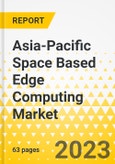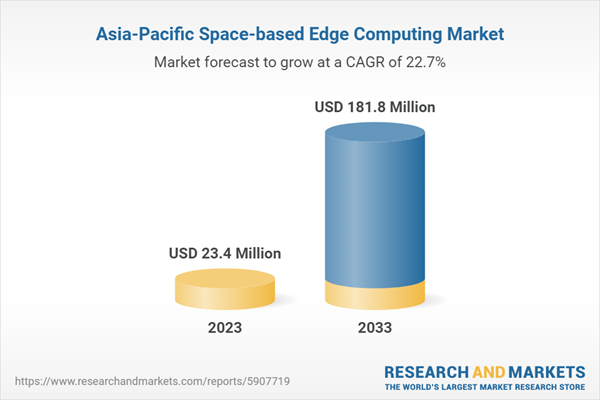This report comes with 10% free customization, enabling you to add data that meets your specific business needs.
Market Introduction
With the introduction of Akamai's content delivery network (CDN) in the 1990s, edge computing came into being. The plan was to physically relocate nodes in order to provide stored media, such as images and videos, closer to the user. The first desktop computers were developed in the late 1970s, during which time major tech companies such as IBM, Intel, Microsoft, and Apple started to appear. This was made possible by the advancement of microprocessors and other micro-tech. The market for edge computing has expanded since then and is expected to do so in the future. The increasing need for moving data centers in space and for latency reduction in space has led to a rise in popularity for one aspect of edge computing: space-based edge computing.At the moment, low Earth orbit (LEO) satellite constellation development is a major global priority for numerous space agencies and commercial enterprises. The market for space-based edge computing would be driven by this. The development of cost-effective edge computing components through increased research and development efforts is another driver fueling the market for space-based edge computing.
Market Segmentation:
Segmentation 1: by End User
- Commercial
- Defense
- Civil Government
Segmentation 2: by Country
- China
- India
- Japan
- Rest-of-Asia-Pacific
How can this report add value to an organization?
Product/Innovation Strategy: The product segment helps the reader understand the different types of space-based edge computing markets available for deployment in the industries for space platforms and their potential in apac region. Moreover, the study provides the reader with a detailed understanding of the different space-based edge computing market by application (commercial, defense, and civil government).Growth/Marketing Strategy: The APAC space-based edge computing market has seen major development by start-up players operating in the market, such as business expansion activities, contracts, mergers, partnerships, collaborations, and joint ventures. The favored strategy for the companies has been contracted to strengthen their position in the APAC space-based edge computing market.
Competitive Strategy: Key players in the APAC space-based edge computing market analyzed and profiled in the study involve space-based edge computing services and space-based edge computing product providers. Moreover, a detailed competitive benchmarking of the players operating in the APAC space-based edge computing market has been done to help the reader understand how players stack against each other, presenting a clear market landscape. Additionally, comprehensive competitive strategies such as contracts, partnerships, agreements, acquisitions, and collaborations will aid the reader in understanding the untapped revenue pockets in the market.
Key Market Players and Competition Synopsis
The companies that are profiled have been selected based on inputs gathered from primary experts and analysing company coverage, product portfolio, and market penetration.Some of the prominent names established in this market are:
- AICRAFT
- Spiral Blue
- SkyServe
This product will be delivered within 3-5 business days.
Table of Contents
Executive Summary
The Asia-Pacific space-based edge computing market is estimated to reach $181.8 million by 2033, reveals the premium market intelligence study. The study also highlights that the market is set to witness a CAGR of 22.74% during the forecast period 2023-2033.The Asia-Pacific Space-Based Edge Computing Market: Drivers and Challenges
Asia-Pacific region has the advantage of having the largest manpower and resources count over their rival regions, which enables them to put in more work in the research, development, and production end for their space-based edge computing market. Furthermore, with more launches planned to take place over the course of the coming years, the space-based edge computing market is expected to see a rise in demand for this region.The majority of the space in the APAC region is dominated by India as it has a large number of companies out of other countries in the region, and so the space segment is dominated by it; hence the development and research in the space-based edge computing market are low as compared to others.
USPs of report
- A dedicated section on growth opportunities and recommendations
- Analysis of business drivers and challenges of the Asia-Pacific Space-Based Edge Computing Market
- Detailed analysis of Space-Based Edge Computing Market for China, India, and Japan
- A detailed company profile comprising established players
Analyst’s Perspective on Asia-Pacific Space-Based Edge Computing Market
The Principal Analyst states, 'The need for resilient operations across communication networks is on the rise. The satellite-enabled networks catering to commercial and military customers operate under dynamic environments, which get contested and degraded in random fashion owing to a multitude of factors. Edge computing as a capability enables end users to navigate through these network challenges and perform mission-critical operations. Similar edge computing capabilities at the satellite/upstream level also enable functionalities that help end users.The demand for space-based edge computing capabilities across upstream and downstream segments is on the rise as a consequence, and this is resulting in new hardware and software capabilities being integrated into satellite-based communication networks across the value chain. It is imperative for the space and ICT market participants to better understand this emerging market to ensure they stand eligible to leverage the revenue opportunities that are expected to evolve as a consequence of the ongoing developments. The market developments, demand assessment, and opportunity overview are included in this study, which aims to enable decision-making with respect to space-based edge computing.'
Key Questions Answered in the Report
- What are the futuristic trends in the Asia-Pacific space-based edge computing market, and how is the market expected to change over the forecast period 2023-2033?
- How is the market expected to grow during the forecast period 2023-2033?
- What are the key developmental strategies implemented by the key players to sustain in this highly competitive market?
- What is the current and future revenue scenario of the Asia-Pacific space-based edge computing market?
Companies Mentioned
- AICRAFT
- Spiral Blue
- SkyServe
- Service Portfolio
Table Information
| Report Attribute | Details |
|---|---|
| No. of Pages | 63 |
| Published | November 2023 |
| Forecast Period | 2023 - 2033 |
| Estimated Market Value ( USD | $ 23.4 Million |
| Forecasted Market Value ( USD | $ 181.8 Million |
| Compound Annual Growth Rate | 22.7% |
| Regions Covered | Asia Pacific |
| No. of Companies Mentioned | 4 |









